Most Filipinos would not rather think about disasters now that Christmas is around the corner; but the fact that the world is in the middle of a pandemic shows that crises can strike at any given time.
Given the country’s location within the Pacific Ring of Fire, and that the Philippines experiences the most number of typhoons than anywhere else in the world, Filipinos should make disaster preparedness a daily habit and part of their culture.
To help achieve this, Panahon TV, which has long advocated disaster preparedness from its birth almost a decade ago, has a timely and useful gift for Filipinos this holiday season—the gift of disaster preparedness. A free webinar moderated by Panahon TV Reporter Patrick Obsuna will feature distinguished speakers and veterans in the field of disaster preparedness. Martin Aguda, author of Ready 101 and national representative to the International Association of Emergency Managers will talk about risk awareness, emergency planning, acquiring survival supplies, and the skills and drills needed to survive disasters. Meanwhile, Sandy Montano, an earthquake survivor and the CEO of Community Health Education Emergency Rescue Services (CHEERS) will shed light on government response during disasters, and the important role of women in preparedness.
Disaster Preparedness during the Pandemic will air on December 22 at 2 pm. Though the webinar is free, monetary donations are welcome and will be given to the Philippine Disaster Resilience Foundation for victims of Super Typhoon Rolly and Typhoon Ulysses.
To join the webinar, register here: https://bit.ly/2LBm5X3
One night, fifteen years ago, Lea was flipping through the channels on her television, looking for a movie to help her destress from her job as a financial adviser in one of the country’s top insurance companies. Instead, her channel surfing took her to a show on yoga, which kept her glued until the end. Watching the gentle flow of yoga poses helped relieve her stress, which kept her tuning in to the show regularly, until she found herself practicing yoga. “I fell in love with yoga since then. I loved how it had a holistic approach to health, focusing on both physical and mental abilities.”

For ten years, she dabbled with yoga until five years ago when she decided to make it her daily practice. “At that time, I was feeling exhausted and stressed. My body was pleading for a break. I decided to focus on myself.” With her regular yoga practice, Lea discovered a more focused way of thinking, and with this clarity came the realization of what she wanted to do with her life. “Two years ago, I decided to go to Vietnam to undergo training so I could be a yoga teacher. Our yoga class had five teachers, which we called masters. We would start our practice with pranayama, or breathing exercises coupled with meditation. It taught me to focus on my breath and to be still in the present. In the stillness, I could hear what my mind and body were telling me.”
Her six-month training certified Lea as a yoga teacher. Because of the pandemic, Lea holds online yoga classes, not just for Filipinos, but also for friends she made in Vietnam. At the same time, she supports her husband in developing an organic vegetable garden in Rizal. He focuses on growing high-nutrient fruits and vegetables that complement Leah’s yoga practice. Though Lea is living proof of yoga’s ability to help regulate blood pressure, fight insomnia and support the body’s natural healing process, she finds that the most important thing she gained from her practice is mental strengthening. “A weak mind can’t carry a strong body, but a strong mind can carry even the weakest body,” she shares. “A strong mind will keep you stable and grounded. It gives you the power to cope with stress.”
This October 14, Lea will share simple breathing and meditation exercises in Panahon TV’s much-awaited webinar, Peace of Mind during the Pandemic, which also features psychiatrist Dr. Rowalt Alibudbud, and Dr. RJ Naguit, chairman of the Youth for Mental Health Coalition, Inc.
From this webinar, Lea hopes that participants will learn to let go of things they can’t control. “Stress is inevitable, but what’s more important is that you know how to manage it. If you’re on a continuous fight-and-flight mode, you’ll get sick. Gentle yoga helps release the tension with mindful poses. Just by focusing on your breath, you honor your body, allowing acceptance, awareness and letting go. When you do this daily, you develop a calm state of mind. It’s a powerful tool to manage everything that’s happening in the world today.”
To register for the webinar, click here: https://panahon.tv/webinar/index.php
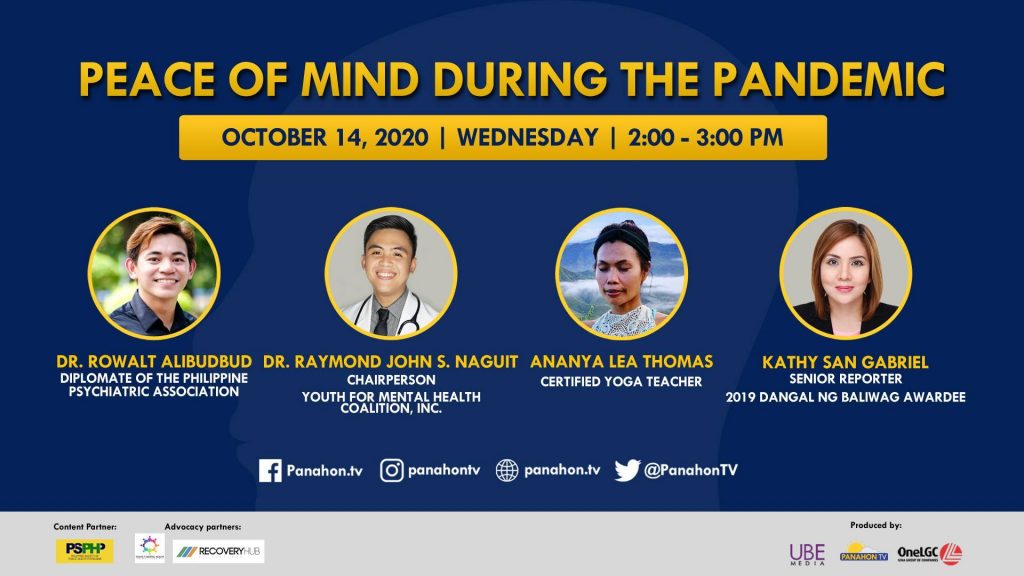
Whenever veteran broadcast journalist Kathy San Gabriel appears on television, she looks sensational—not a hair out of place, make up on point, and always appropriately dressed for the occasion. Throughout the course of her more than 20 years in the industry, she has always been vigilant about delivering fair and accurate news, never veering toward the sensationalistic side of reporting.
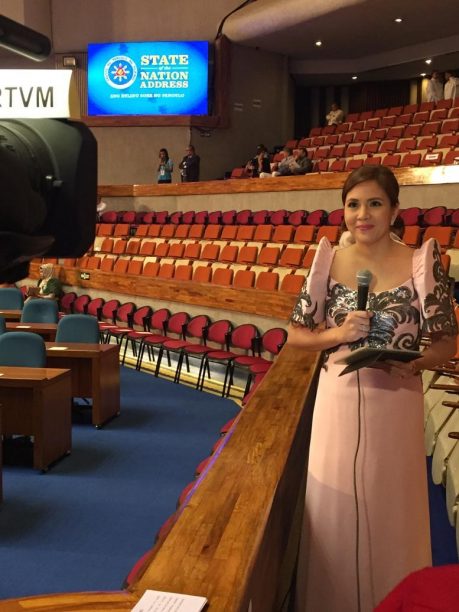 Kathy covering former President Benigno Aquino III’s state of the nation address in 2015
Kathy covering former President Benigno Aquino III’s state of the nation address in 2015
This comes as no surprise from someone who grew up watching Cheche Lazaro on The Probe Team, and Loren Legarda on Pep Talk. Kathy reveals that she’s always dreamed of being a journalist, which was why she took up Broadcast Communication at the University of the Philippines in Diliman.
After graduating, she took her first step in fulfilling her dream. “I started my career as a journalist in Sarimanok News Network, which we now know as ANC. My first job was to do the top-of-the-hour newsbreaks from 12 midnight to 5 a.m. I was eventually transferred to the day shift and did some reportorial work as well. I was then asked to do primetime newsbreaks on Channel 2, became part of their pool of reporters, and was given a 30-minute newscast on DZMM.”
After taking a break from 2004 to 2005 because of her pregnancy, Kathy went back doing the news for state-run network, PTV. After 11 years, she transferred to Panahon TV as a senior reporter. In 2019, she received the Dangal ng Baliwag, an award given to ten outstanding individuals who excelled in their respective fields, and hailed from Baliwag, Bulacan.
To get to know more about Kathy’s journey, Panahon TV asked her a few questions.
 Kathy’s photo of Pope Francis during his state visit to the Philippines in 2015
Kathy’s photo of Pope Francis during his state visit to the Philippines in 2015
What are your most memorable coverages?
Impeachment trials of former President Joseph Estrada and former Chief Justice Renato Corona, Pope Francis’s state and apostolic visit to our country, several SONAs, and Typhoon Yolanda. For me, the highlights of my career include working with broadcasting pillars like Frankie Evangelista and Angelo Castro, and veteran journalists like Angelo Palmones and Freddie Abando. I learned a lot from them.
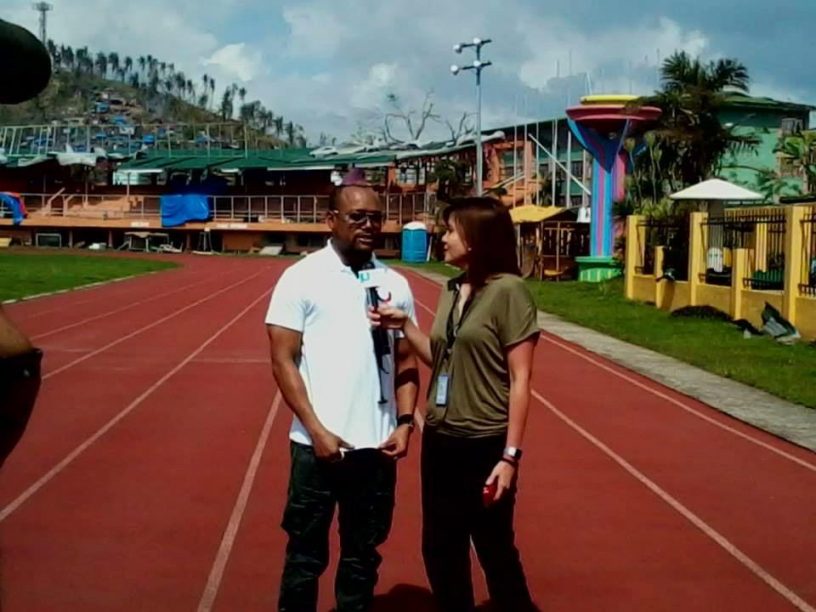 Kathy interviewing apl.de.ap in Tacloban as part of Typhoon Yolanda relief efforts in 2013
Kathy interviewing apl.de.ap in Tacloban as part of Typhoon Yolanda relief efforts in 2013
What are the challenges of being a broadcast journalist?
I think the main challenge that all journalists are facing now is the attack on press freedom. That is why journalists and other members of the media need to hold the line. Another challenge is disinformation. “Fake news” is something that we have to fight on a daily basis. We journalists need to uphold the principles of truthfulness, accuracy, and impartiality now more than ever.
What have you learned from being a senior reporter at Panahon TV?
I’ve learned a lot about feature reporting and segment production, and also about the environment. This niche is entirely new to me since I spent two decades doing hard news and current events.
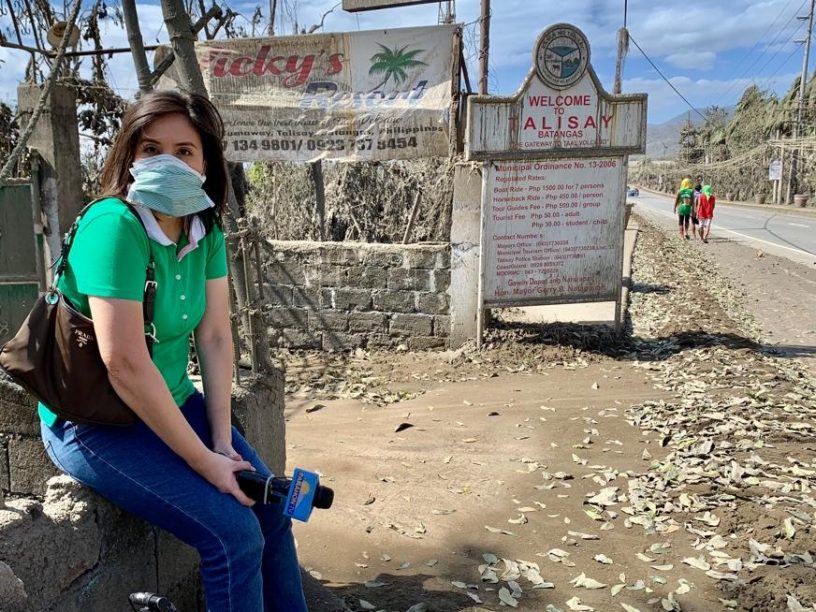 Kathy reporting about the effects of Taal’s eruption earlier this year
Kathy reporting about the effects of Taal’s eruption earlier this year
You have an upcoming Panahon TV webinar, Journalism 101, designed to teach the basics of journalism. How are you feeling about it?
This is something new for me, so I’m excited to be a part of it. I hope that some, if not most, of our participants will continue along the path to being a journalist. I hope that they’ll turn out to be some of the good ones.
What do you hope participants will learn about journalism?
I always say this when I give talks— if you’re in journalism for the glamour, then you’re in it for the wrong reasons. Being a journalist is hard work. It’s being accountable to your audience.
How important is journalism now during the pandemic?
Journalism is more important than ever during a pandemic. We are inundated on social media with unverified information on COVID-19. It is the duty of journalists to provide the public with accurate information, which can mean life and death.
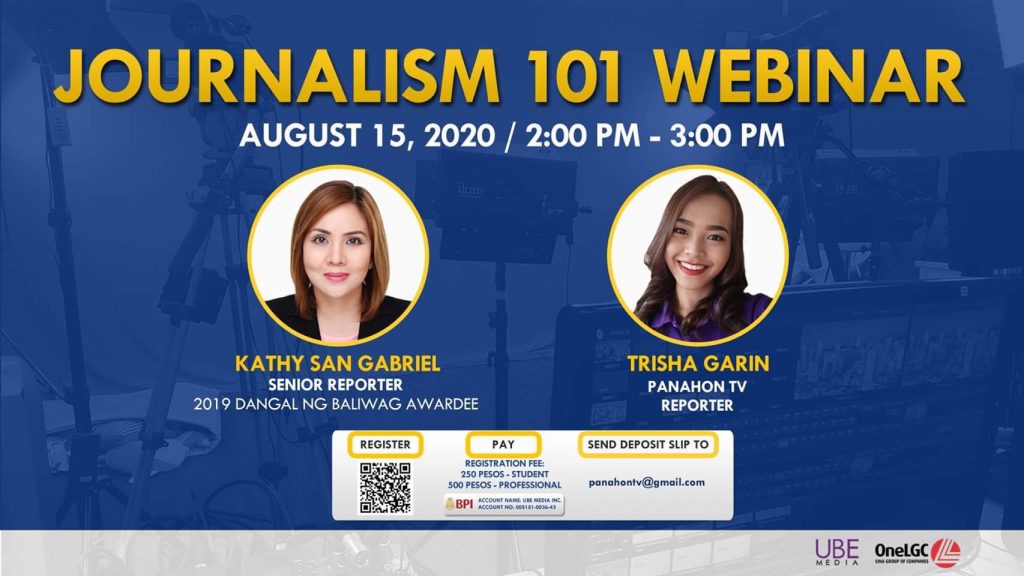
To register for Panahon TV’s webinar, Journalism 101 with Kathy San Gabriel, click on this link: https://bit.ly/2X6oV9p
Time flies when you’re having fun, and seems to slow down when you’re in a less desirable situation. But time is more than the numbers glowing on our phones and watches; it is a fascinating ode to astronomy.
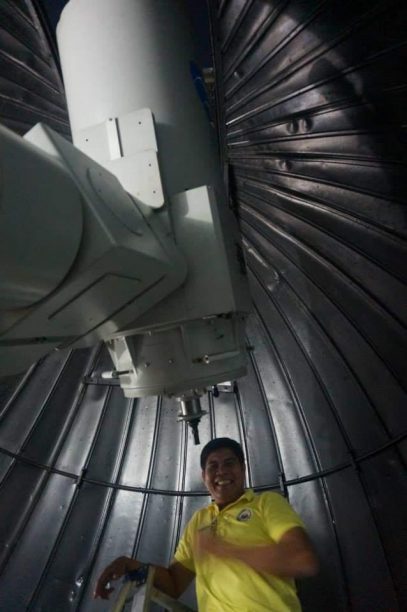 Raymundo with a 45-cm GOTO Telescope, the largest optimal telescope in the country, at the PAGASA Astronomical Observatory in the University of the Philippines.
Raymundo with a 45-cm GOTO Telescope, the largest optimal telescope in the country, at the PAGASA Astronomical Observatory in the University of the Philippines.
When Electrical Engineer Mario Raymundo first entered the Philippine Atmospheric, Geophysical and Astronomical Services Administration (PAGASA) office in 1993, he was assigned to the weather’s bureau’s time service unit. Here, he learned how time could be measured by observing the movement of celestial bodies, and how time zones in different parts of the world are based on the fact that it takes the Earth one hour to turn 15 degrees.
As time went by, it seemed almost natural for Raymundo to gradually expand his knowledge and duties to include astronomy. “As an engineer, I was well-versed in mathematics, including trigonometry. But in astronomy, I learned spherical trigonometry to make observations on the celestial bodies.”
Decades later, Raymundo is now chief of the PAGASA Astronomical Observation and Time Service Unit. “We use a 45-centimeter telescope to observe variable stars. During the daytime, we study and photograph sun spots.” Sun spots or dark spots that appear on the Sun’s photosphere may have an effect on the Earth’s weather patterns. Meanwhile, variable stars or stars that change their brightness are studied to possibly discover other stars and signs of life in the galaxy.
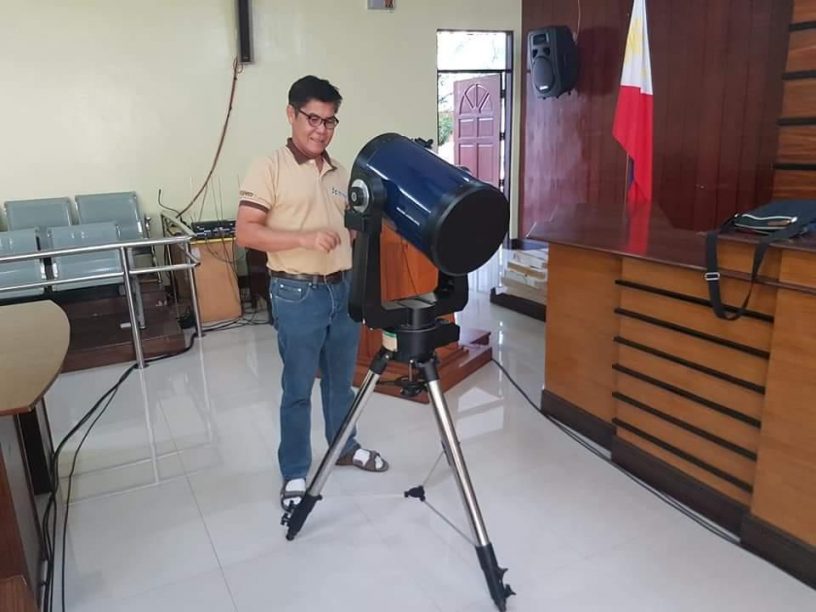 Raymundo with a compound telescope
Raymundo with a compound telescope
Astronomy for Filipinos
Raymundo admits that the study of astronomy in the Philippines is limited because of the lack of funding for high-cost equipment. “Astronomy equipment is very expensive. A 1-meter telescope alone costs a million (US) dollars, which is roughly 50 million pesos. You can feed a lot of Filipinos with that amount.” Still, Raymundo believes that PAGASA provides a good foundation for future Filipino astronomers. “We have to start somewhere to impart the knowledge to future generations. Before the pandemic, we regularly visited schools with our mobile planetarium to conduct lectures.”
Despite the challenges, Raymundo says astronomy remains significant for Filipinos. “A lot of Filipinos are hungry for astronomical knowledge. In science textbooks in schools, only 7 to 8 pages are dedicated to astronomy, offering only general facts. When we conduct lectures, we give students direct knowledge. Through the planetarium, they better understand why celestial bodies are positioned in certain ways, and the importance of the Polaris or North Star. It’s easier to explain things that way.”
 Annular Solar Eclipse in December 2019 in Balut Island in Saranggani, Davao Occidental
Annular Solar Eclipse in December 2019 in Balut Island in Saranggani, Davao Occidental
 Training in Spain on Astronomical Observation which lasted for several months
Training in Spain on Astronomical Observation which lasted for several months
Astronomy saves lives
But astronomy is not only a passive observation of the skies; it can also save lives. In 2013, an asteroid about the size of a six-story building blasted over Chelyabinsk in Russia. Its explosion generated a shock wave that shattered glass and injured over a thousand people. “Outer space can bring disasters,” Raymundo says. “In reality, thousands of meteors enter our planet, but they usually disintegrate before hitting our surface. The one that exploded in Russia was unexpected, so we need people to be aware that this kind of disaster is possible.”
On July 15, Panahon TV will host a free webinar called Understanding Space with Raymundo as the speaker. “I’m excited because it’s my first time to conduct an online lecture. It’s a different approach and I’m looking forward to the results.” When asked what he’s excited to share with the webinar participants, Raymundo says, “I hope to better explain to them the things they read in books. Everything from the constellations to the zodiac, I will be able to describe in detail.”
Catch Chief of PAGASA Astronomical Observation and Time Service Unit Mario Raymundo in Panahon TV’s free webinar, Understanding Space, on July 15, 2020 at 2 pm. To register, click here: https://bit.ly/2Z7TJa4
Weather is no longer a mundane topic people use to make small talk. Nowadays, news about the weather makes Filipinos straighten up and listen because of the countless ways it impacts their lives. This is precisely what inspires PAGASA Weather Specialist Ariel Rojas when he delivers the forecast—with his eyes alert and his hand sweeping across the graphics-generated Philippine map.
“I’ve always been curious about the weather. I was born and raised in Bicol where it always rains and tropical cyclones always visit,” he shares. His journey toward weather forecasting began when he took up B.S. Meteorology in UP Diliman’s graduate school under a PAGASA scholarship. In 2017, he began working in PAGASA, and had since been trained here and abroad, allowing him to gain new knowledge and techniques in weather forecasting.
Rojas regularly appears on Panahon TV to deliver the weather forecast, but with Panahon TV’s first free webinar, Intro to Philippine Weather, he’ll get to share more of his knowledge. We sat down with him to delve deeper into his childhood passion.

What are your current duties in PAGASA?
My main duties include analyzing weather data, maps, and models to formulate weather forecasts, and presenting the forecast product to the public through PAGASA’s online platforms and interviews with media outlets. I also conduct lectures on weather forecasting or other weather-related topics to media practitioners and students.
Do you think it’s important for Filipinos to have basic weather knowledge?
Yes, it is! The Philippines is the most tropical cyclone-visited country in the world! That alone should be enough reason. We are also an agricultural nation so many farmers depend on the rain. Our economic, agricultural, and other daily activities are informed by the state of the atmosphere so basic weather knowledge is a must for everyone.
If there’s one thing you’d like every Filipino to know about weather forecasting, what would it be?
That weather presenting is only the tip of the iceberg. Forecasters analyze weather data, maps, and models to come up with the final forecast and all of these take time. Tropical cyclone events require more time and harder analyses.
How do you feel about being part of the Panahon TV webinars?
I always look forward to joining Panahon TV activities because they’re fun and I learn a lot. I feel honored to have been invited to take part in this webinar. I am also trying to further hone my communication skills so this would be a great platform for that.
What do you hope participants will take away from your workshop?
I hope that they will carry with them whatever little nugget of weather knowledge they can take away from the workshop. We basically experience the same weather patterns every year so just knowing when these patterns change can greatly help them in their decision-making, even the most mundane ones like choosing which clothes to wear or when to book an out of town trip.
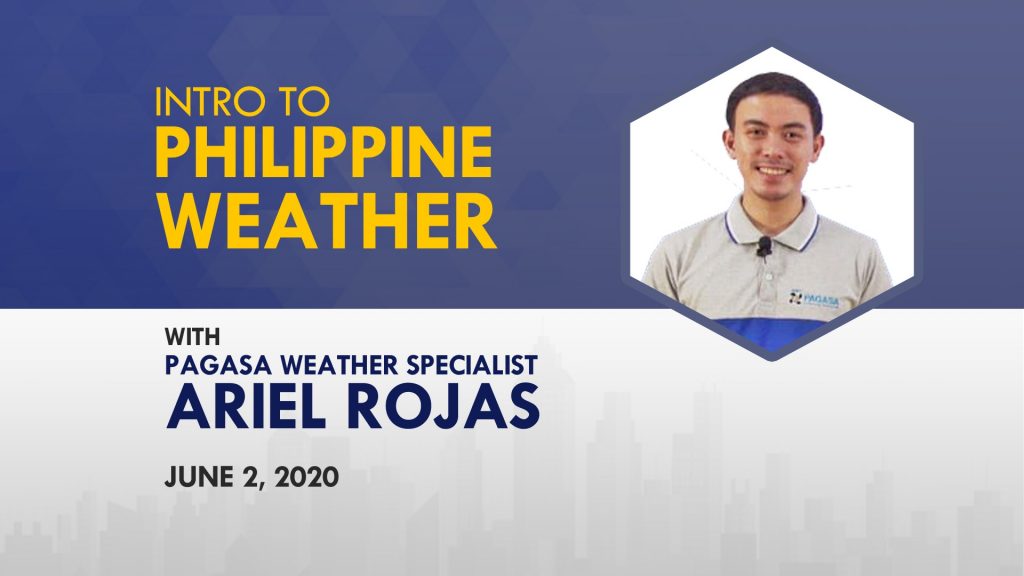
To join Panahon TV’s free webinar Intro to Philippine Weather with Ariel Rojas on June 2, 2020 at 2:00 p.m., register at https://bit.ly/3d70vTk .

